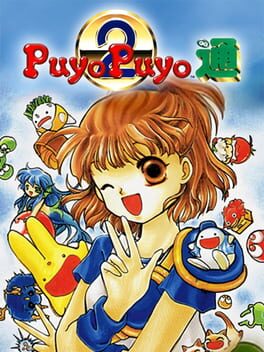We can certainly praise Puyo Puyo Tsu for presenting essential new rules to the series; as seckswrecks said to me a ways back, completetive Puyo was just a race to get a 5-chain before Tsu. But I have a bolder hypothesis: Puyo Puyo Tsu originated four completely new rules to the stacker genre which would become foundational to literally all stacker design to come, literally forever. Please call me out if you have counter-examples, documentation is limited and i still have (regrettably) not yet played every puzzle game. I'll include counter-examples in edits to this document. Anyway, here are those rules, gathered via PuyoNexus:
1) "offset rule," what i've called garbage cancelling: to paraphrase PuyoNexus, "the player can reduce or 'offset' the amount of incoming garbage with their own garbage; should the player completely negate all incoming garbage, any excess will be sent to the opponent." as i've oft opined, this rule is what makes multiplayer stackers work. it is near-universal in any game with queued garbage.
2) "margin time": after a certain amount of time has passed, the game will intensify the effect of chains by making the same chain send more garbage. one can apply the concept of margin time to any mechanic that speeds up or intensifies over the course of a single match, tightening the execution window or heightening the risk/reward tension. this maps the increasing speed one encounters over long plays of tetris or columns into a shorter multiplayer format.
3) "all clear": if a player manages to clear their field of pieces after the game starts, they receive a bonus to points/garbage. this bonus drives the most brutal strategies in the Tetris meta today.
4) "double rotation": if a piece is falling through a column too narrow to rotate, the player can double-tap the rotate button, and the top and bottom pieces will swap.
To me, these four mechanics are up there with "color matching," "chaining," "rotation," "wallkick," and "garbage" with their impact on our budding genre. (maybe not "double rotation" as much, but the first three, yeah absolutely, i'd defend that.) first or not, here they are together in 1994: four years after Columns, six years after the first commercial releases of Tetris, nine years after CHAIN SHOT, fourteen years after PAC-MAN, at least 3300 years since fucking Tic-Tac-Toe. unlike Tetris (1985), which spawned Tetris clones (many of which were not very good), and Columns (1990), which spawned Columns clones (many of which have naked ladies in them), Puyo Puyo Tsu (1994) spawned the competitive puzzle game as we know it today. what Puyo Puyo Tsu introduced, the world grabbed; what Puyo Puyo Tsu refined, the world swallowed; what Puyo Puyo Tsu meant, the world became.
...which is all perhaps a bit much for a junior researcher of puzzle games to say! like, i didn't know what CHAIN SHOT was until writing this. but this is that which my heart sings right now, so i hope old heads don't rag on me too hard about this. i hope to revisit this at the end of the project, but for now: a perfect 10/10.
1) "offset rule," what i've called garbage cancelling: to paraphrase PuyoNexus, "the player can reduce or 'offset' the amount of incoming garbage with their own garbage; should the player completely negate all incoming garbage, any excess will be sent to the opponent." as i've oft opined, this rule is what makes multiplayer stackers work. it is near-universal in any game with queued garbage.
2) "margin time": after a certain amount of time has passed, the game will intensify the effect of chains by making the same chain send more garbage. one can apply the concept of margin time to any mechanic that speeds up or intensifies over the course of a single match, tightening the execution window or heightening the risk/reward tension. this maps the increasing speed one encounters over long plays of tetris or columns into a shorter multiplayer format.
3) "all clear": if a player manages to clear their field of pieces after the game starts, they receive a bonus to points/garbage. this bonus drives the most brutal strategies in the Tetris meta today.
4) "double rotation": if a piece is falling through a column too narrow to rotate, the player can double-tap the rotate button, and the top and bottom pieces will swap.
To me, these four mechanics are up there with "color matching," "chaining," "rotation," "wallkick," and "garbage" with their impact on our budding genre. (maybe not "double rotation" as much, but the first three, yeah absolutely, i'd defend that.) first or not, here they are together in 1994: four years after Columns, six years after the first commercial releases of Tetris, nine years after CHAIN SHOT, fourteen years after PAC-MAN, at least 3300 years since fucking Tic-Tac-Toe. unlike Tetris (1985), which spawned Tetris clones (many of which were not very good), and Columns (1990), which spawned Columns clones (many of which have naked ladies in them), Puyo Puyo Tsu (1994) spawned the competitive puzzle game as we know it today. what Puyo Puyo Tsu introduced, the world grabbed; what Puyo Puyo Tsu refined, the world swallowed; what Puyo Puyo Tsu meant, the world became.
...which is all perhaps a bit much for a junior researcher of puzzle games to say! like, i didn't know what CHAIN SHOT was until writing this. but this is that which my heart sings right now, so i hope old heads don't rag on me too hard about this. i hope to revisit this at the end of the project, but for now: a perfect 10/10.
